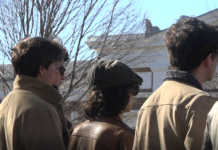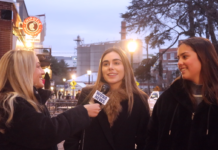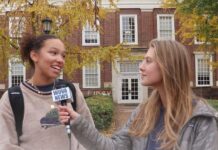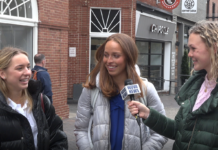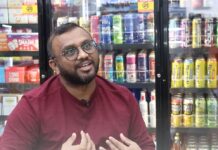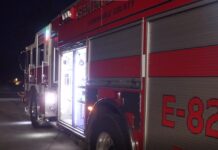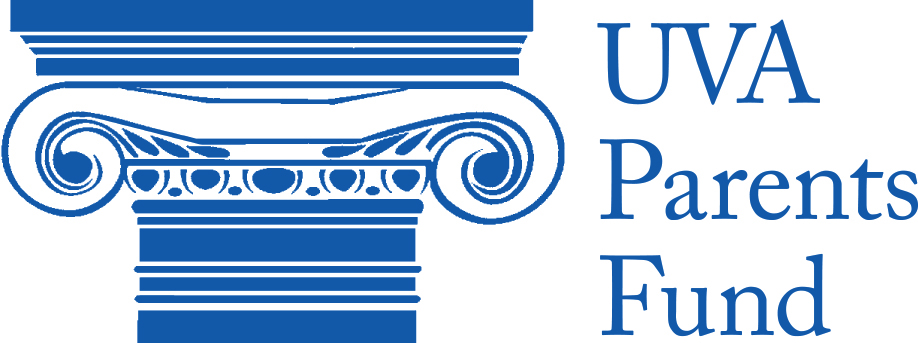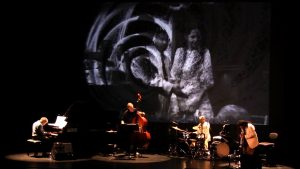
Last month, the UVa McIntire departments of Art and Music co-hosted a new music festival centered on diversity, the Impulse Festival of Improvisation, that featured four concerts, a student jam session, and a series of workshops and lectures.
The festival began Wednesday night with a lecture and demonstration by video artist Jesse Gilbert. Around twenty people, myself included, filed into a medium-sized lecture hall in Campbell Hall to hear his talk. He explained his background studying and teaching at CalArts, then discussed his fellowship in Ghana, which piqued his interest in West African music and motivated him to better represent it in Western society.
While he was serving as the founding chairman of the Media Technology department at Woodbury College, Gilbert invented SpectralGL, a software instrument for interactive art. This could be a tool to better represent not only West African music, but all music.
SpectralGL is a visual instrument that generates real-time 3D animation in response to live or recorded stimuli. Gilbert defined it as, “A reflection on the listening process.” He then demonstrated it in use. On the screen behind him appeared a waveform in front of a black background. As he talked, it would react accordingly, waves bouncing and dipping to his voice. Then, it grew colorful, with different colors representing different pitches. Then, the waveform turned sideways and scrolled left to right like an old 8-bit side-scroller game, eventually bouncing into three dimensions and weaving around itself and invisible shapes.
This invention was on display during Saturday’s headlining act, Wadada Leo Smith and the Golden Quintet–but before we get there, three concerts come first.
The First Concert
The first concert, “Origins”, took place on Friday night. The UVa Baroque Orchestra, a group comprised of seven students led by David Sariti, performed first. They played to a crowd of roughly fifty people in Old Cabell Hall, improvising on notations by Corelli. Sariti played with remarkable passion and animation, and the students all shone in their own way during their solos. It was unexpectedly moving. And then their set was done.
The second group was a small jazz ensemble featuring Stephanie Nakasian, an exuberant singer hailed by the Biographical Encyclopedia of Jazz as “One of the leading jazz singers in the world today.” She was joined by Cameron Fard on tenor sax, Matthew Angeley on alto sax, Anna Wolz on trombone, Declan Prendergast on piano, Chethan Shivaram on guitar, Ethan Blaser on bass, and Rami Stucky on drums. Together they played a lively set, Sakasian scat singing with an amazing pitter-patter, sounding at times like a brass instrument melting syllables together with remarkable ease.
As they improvised, a striking sense of vitality permeated as they played off each other and prompted responses in their solos. It was reminiscent of the jazz scene in La La Land. There was something exciting and at the same time comforting about the spontaneity of it.
The final group of that Friday Origins concert was the Swaraprabha Hindustani Classical Indian Vocal Ensemble, with vocalists Avani Abhyankar, Aashni Shetty, and Arghya Shetty led by Nirmal Bajekal, who were joined by Mayuresh Abhyankar on tabla. Abhyankar is also a faculty member in the Division of Infectious Diseases here at UVA. The tabla he played are small drums with long tuning strings on the side and black circles in the center of the drumheads.
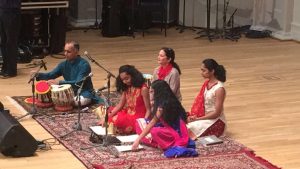
The five of them performed sitting on Persian rugs that Bajekal said were, “Night rugs, appropriate for this time of day.” It was almost 9:30 after all. Bajekal went on to explain the nature of Hindustani music and the improvisation, which she said they did beforehand.
They sang songs full of energy and vibrance, with beautiful harmonies and hypnotic repeating structures. Abhyankar played with amazing speed and rhythm on the tabla. When it was done, the crowd applauded for a solid minute. And with that, the Origins concert was over.
The Second Concert
At noon on Saturday, the “Meditations” concert began. Ayman Fanous played a 25 minute set of improv guitar to a crowd of thirty or so. He started on the electric guitar, leaning forward and holding the guitar close as he plucked a steady, jazzy tune. He followed that by standing the guitar up like a cello and playing near the bridge with a small tube while fingering the strings by his head. The guitar produced a very ominous tune that sounded almost as if it was coming from a very old record player. He finished with a fiercely played song on the mandolin.
He was followed by Stephen Nachmanovitch on the violin. Nachmanovitch began his set by singing into the mic his thanks to the crowd and the festival runners. Then he set off into a very dramatic performance. At one point, an usher’s phone goes off and Nachmanovitch responds emphatically in song. It was an impassioned performance, that he finished by saying, “As musicians, we don’t all improvise, but we all have a voice. And this is a time when we need to use our voice.”
The final performer of the “Meditations” concert was a pianist named Anthony Davis. Davis has written five operas and is a professor of Experimental Practices at UC San Diego. He does not say anything when festival director Greg Howard introduces him, he simply walks on stage, sits at the piano bench, and begins to play. His feet tap and bounce beneath the piano as he plays an incredibly energetic piece full of feeling if not melody. He played three pieces from operas he had written, and he closed with “Evidence” by Thelonious Monk. The crowd response was mixed, unsurprisingly. His style of play can be polarizing, focused very much on energy and arrangement than hooks or sweet melodies. He bowed earnestly and left. He would later return for the headlining act.
The Third Concert.
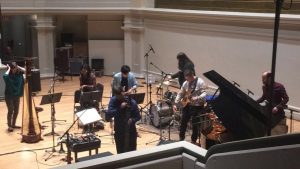
The second concert on Saturday, “Conversations”, began with the UVa New Music Ensemble accompanied by Greg Howard. They started out with a very spacey song, one I could imagine hearing in 2001: A Space Odyssey. After that, they transitioned to a very experimental song featuring whispers and spoken word over sporadic instrumentation and improvised rubbing of pant legs. The pianist reached into the piano and plucked the strings directly. What was most interesting was watching their wordless communication on stage. They gestured and signaled to arrange new movements, to speed up or slow down, to grow louder or softer. The cries from an audience member’s baby were almost harmonious with the song.
The second group, “Azul”, featured John D’Earth on trumpet, Greg Howard on Chapman stick, and Brian Caputo on drums. I should explain the Chapman Stick. It is a ten to twelve string guitar that can play multiple musical parts simultaneously. Howard was introduced as a “world leader” on the instrument.
Azul’s set was energetic and sometimes mysterious, and consistently featured build-ups in intensity and reached frenzied fever pitches that felt grandiose in a way. Every player was interesting to watch. D’Earth played with spontaneous eruptions of energy on the trumpet, Howard lay down layered harmonies and a couple killer solos on the Stick, and Caputo played with frantic intensity on drums, often switching sticks. It was an enthralling performance.
The last group, “EcoSono”, improvised songs over field recordings of places they have traveled–Australia, Colorado, Alaska, and Virginia–which featured a recording from an underwater oyster bed excursion. Greg Howard introduced the group with a joke, “It’s like Jimi Hendrix meets National Geographic.” Saxophonist Matthew Burtner described their music as “A celebration of biodiversity.”
Their playing was erratic and intense, sounding at times like whales fighting. All four sections were part of one continuous song. The first section built in intensity until it reached a peak of chaos. It was the epitome of freeform jazz. At one point later in the song, Burtner began rubbing together what appeared to be rocks in rhythm with the music while the cellist rubbed two bows together. Burtner later ran his hand through a bucket of water to accent the song. The music itself did seem to resemble the natural sounds, and they certainly complemented one another.
The Final Concert.
At 8:00 on Saturday night, it was time for Wadada Leo Smith and the Golden Quintet to play. There was a fairly large crowd packed into the seats at Old Cabell. The massive new screen was hanging down in front of Raphael’s “School of Athens”. This concert marked the first time Old Cabell’s new audiovisual equipment was put to use.
Smith teaches at CalArts. His 2012 album Ten Freedom Summers made him a finalist for the Pulitzer Prize for Music. His 2016 album America’s National Parks had never been performed in full before this concert, and it will not be performed in full again until next year, when he is scheduled to play at Carnegie Hall.
Smith was joined on stage by the rest of the Golden Quintet, featuring Anthony Davis on piano, Pheeroan akLaff on drums, Ashley Walters on cello, and John Lindberg on the upright bass. The room went dark as they took their positions and an image of the New Orleans skyline at sunset filled the large screen.
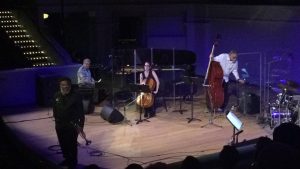
The music created an incredible atmosphere, truly filling the space as the images on screen warped with the sounds. Gilbert’s SpectralGL was on full display. Occasionally, the morphing waveforms were overlaid with video of the performers, which created a mixed image that accented the music in an entrancing way.
Smith’s trumpet shrieked and wailed over the sounds of the other instruments, soaring across the room and bouncing off the walls before receding back into the background. He often sat down in between intense bouts of playing. The cacophony of music was at times mesmerizing, and at times disorienting. Lindberg’s bass solo was stunning, and Walters’ solo on cello was beautiful and vibrant.
After almost a half-hour, the first song ended. The Golden Quintet’s music was also polarizing. As they went into the second song, some audience members began to leave, though this tapered off after a point. One could not help but to marvel at the skill of the performers, but not everyone could stick around for the whole set. When the second song ended, more people left.
Throughout the course of the set, Smith would gesture to other players to get coordinated. A couple times, he would put his hand on Davis—to no avail. The pianist continued. As he pounded the keys, Smith’s shoulders dropped in frustration until, finally, Davis looked over. The second time this happened, Smith walked across the stage to Davis and whispered in his ear to stop. The performance was otherwise without hiccup.
By the end of the third and final song, it was around 10:15 and the remaining audience was fully invested in the music. As they closed the set, there were gasps from the crowd. The room erupted into applause and everyone rose to their feet. The Golden Quintet earned a standing ovation.
Smith concluded the set, and thus the festival, with these words, “The Earth is made for humans. At this point, we’ve made extinct [a large percentage] of it. We are greedy. And yet we hope it lasts forever. It cannot. It will not. We’re unintelligent to think it will live on the way we treat it.”







